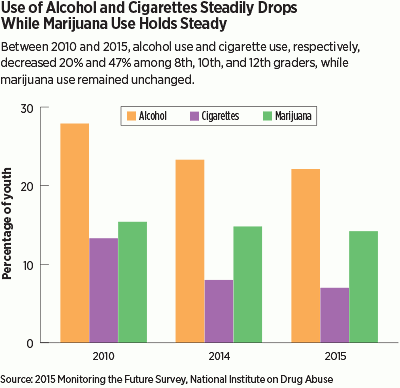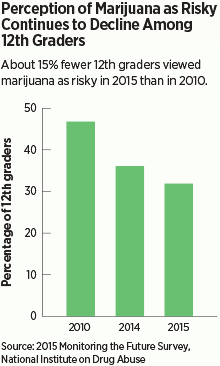In December 2015, the National Institute on Drug Abuse (NIDA) released data from its Monitoring the Future survey revealing that U.S. teens are using alcohol, cigarettes, and some illicit drugs less than they did in 2014. Despite this trend, the survey found that youth’s use of electronic cigarettes and marijuana remained constant.
“We are heartened to see that most illicit drug use is not increasing, non-medical use of prescription opioids is decreasing, and there is improvement in alcohol and cigarette use rates,” Nora Volkow, M.D., director of NIDA, said in a statement. “However, continued areas of concern are the high rate of daily marijuana smoking seen among high school students, because of marijuana’s potential deleterious effects on the developing brains of teenagers, and the high rates of overall tobacco products and nicotine-containing e-cigarettes usage.”
Since 1975, the Monitoring the Future survey has annually asked over 40,000 8th, 10th, and 12th graders across the United States about their use of alcohol, tobacco products, and illicit drugs, as well as their attitude toward such products.
This year’s survey, which included 44,892 students from 382 U.S. public and private schools, found that alcohol use by teens declined, with an average of 22.1 percent of those surveyed reporting past-month use of alcohol—down from 23.3 percent in 2014 and 27.9 percent in 2010. Average rates for past-month cigarette use also declined for the three grades combined, dropping from 13.3 percent in 2010 and 8.0 percent in 2014 to 7.0 percent in 2015.
Adolescents’ use of electronic cigarettes remained relatively stable from 2014 (the first year that youth were surveyed on their use of these products), with 13.2 percent of surveyed participants admitting to having used the products over the past month. When past-month e-cigarettes users were surveyed on the reasons for using the nicotine-vaporizing products, more than 50 percent reported using the product “out of curiosity,” Richard Miech, Ph.D., a research professor in the Survey Research Center at the University of Michigan and a senior investigator of the study, said at a teleconference on the survey findings.
“These results suggest that e-cigarettes are primarily a new way to use recreational substances more so than a means to end tobacco addiction, at least among adolescents,” Miech said.
Past-month marijuana use for all youth surveyed in 2015 was 3.4 percent—a percentage that remained unchanged since 2014. However, for the first time in the history of the survey, daily marijuana use exceeded daily tobacco use among 12th graders, with approximately 6 percent reporting past-month, daily use of marijuana compared with 5.5 percent reporting daily use of cigarettes. According to the survey, the perception by 12th graders that marijuana use is risky continues to decline, with 31.9 percent expressing the opinion that regular marijuana use is harmful compared with 36.1 percent in 2014 and 46.8 percent in 2010.
Other major findings highlighted in the NIDA report included downward trends in youth’s past-year use of synthetic cannabinoids, MDMA (Ecstasy or Molly), heroin, and prescription opioids. ■



